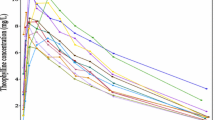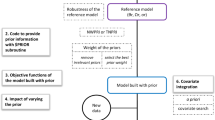Abstract
‘Are two populations the same or are they different’ is a question that is often faced in clinical pharmacology trials e.g., a pharmacokinetic trial studying a particular drug in racially different groups. To address this question, concentration–time data were simulated from a reference and test population, where in the latter the clearance, sample size, and sampling design were systematically varied. It was of interest to determine whether the estimates of clearance from the two groups were the same or different. Two approaches were used to estimate the empirical Bayes estimates (EBEs) for clearance. One approach developed a population pharmacokinetic model for the reference population and the EBEs for the reference population were estimated from this model. The parameters of the reference population were fixed to their maximum likelihood estimates. The model was then applied to the test population dataset to estimate the EBEs of the test population using the MAXEVAL = 0 option in NONMEM. A second approach, the theta approach, combined the reference and test datasets into a single dataset and used population as a covariate in the model; the EBEs were estimated from this combined model. The power and type I error rate of each approach were calculated for each treatment combination using a variety of statistical tests to determine whether there was a difference in the distribution of the EBEs in the reference population compared to the test population. Our results suggest that either MAXEVAL or theta approaches can be used with informative sampling designs. In addition to reasonable power and type I error, both approaches gave almost identical results under a dense sampling design. To statistically compare the distribution of EBEs of pharmacokinetic parameters from a reference group to that of a test group, a T-test and DTS eCDF test are equally useful.








Similar content being viewed by others
References
Center For Drug Evaluation and Research Application Number: 209819Orig1s000 Clinical Pharmacology and Biopharmaceutics Review(S) [Sublocade®]. https://www.accessdata.fda.gov/drugsatfda_docs/nda/2017/209819Orig1s000ClinPharmR.pdf Accessed 23 July 2022
Lanke S, Shoaf SE (2019) Population pharmacokinetic analyses and model validation of tolvaptan in subjects with autosomal dominant polycystic kidney disease. J Clin Pharmacol 59(5):763–770. https://doi.org/10.1002/jcph.1370
Ralph LD, Sandstrom M, Twelves C, Dobbs NA, Thomson AH (2006) Assessment of the validity of a population pharmacokinetic model for epirubicin. Br J Clin Pharmacol 62(1):47–55. https://doi.org/10.1111/j.1365-2125.2006.02584.x
Comets E, Ikeda K, Hoff P, Fumoleau P, Wanders J, Tanigawara Y (2003) Comparison of the pharmacokinetics of S-1, an oral anticancer agent, in Western and Japanese patients. J Pharmacokinet Pharmacodyn 30(4):257–283. https://doi.org/10.1023/A:1026142601822
Reporting and Analysis Plan (RAP) for Dose Escalation and Target Engagement Interims (GSK2330811). https://clinicaltrials.gov/ProvidedDocs/25/NCT03041025/SAP_001.pdf Accessed 23 July 2022
Center For Drug Evaluation and Research Application Number: 209819Orig1s000 Clinical Pharmacology and Biopharmaceutics Review(S) [Prezista®]. https://www.accessdata.fda.gov/drugsatfda_docs/nda/2011/202895Orig1s000ClinPharmR.pdf Accessed 23 July 2022
U. FDA, “Office of Clinical Pharmacology Review [Taxotere®].” https://www.accessdata.fda.gov/drugsatfda_docs/pediatric/020449_docetaxel_clinpharm_BPCA.pdf Accessed 23 July 2022
U. FDA, “BLA 125370/s-064 and BLA 761043/s-007 Multi-disciplinary Review and Evalaution Benlysta® (belimumab) for Intravenous Infusion in Children 5 to 17 Years of Age with SLE.” https://www.fda.gov/media/127912/download Accessed 23 July 2022
Brochot A et al (2015) Model-based once-daily darunavir/ritonavir dosing recommendations in pediatric HIV-1-infected patients aged ≥ 3 to <12 years. CPT Pharmacomet Syst Pharmacol 4(7):406–414. https://doi.org/10.1002/psp4.44
Yu Z et al (2017) Population pharmacokinetics and Bayesian estimation of mycophenolic acid concentrations in Chinese adult renal transplant recipients. Acta Pharmacol Sin 38(11):1566–1579. https://doi.org/10.1038/aps.2017.115
Hwang MF et al (2017) External evaluation of two fluconazole infant population pharmacokinetic models. Antimicrob Agents Chemother. https://doi.org/10.1128/AAC.01352-17
Momper JD et al (2016) Population pharmacokinetics of fluconazole in premature infants with birth weights less than 750 grams. Antimicrob Agents Chemother 60(9):5539–5545. https://doi.org/10.1128/AAC.00963-16
Wade KC et al (2008) Population pharmacokinetics of fluconazole in young infants. Antimicrob Agents Chemother 52(11):4043–4049. https://doi.org/10.1128/AAC.00569-08
Lee PID (2001) Design and power of a population pharmacokinetic study. Pharm Res 18(1):75–82. https://doi.org/10.1023/A:1011030827847
White DB, Walawander CA, Liu DY, Grasela TH (1992) Evaluation of hypothesis testing for comparing two populations using NONMEM analysis. J Pharmacokinet Biopharm 20(3):295–313. https://doi.org/10.1007/BF01062529
Beal S, Sheiner L, Boeckmann A, Bauer R. NONMEM 7.5.1 Users Guides. ICON plc., Gaithersburg, MD. https://nonmem.iconplc.com/nonmem751
C. Dowd, “twosamples R library.” https://cran.r-project.org/web/packages/twosamples/twosamples.pdf Accessed 02 Aug 2022
Hollander M, Wolfe D, Chicken E (2014) Nonparametric statistics. Wiley, Hoboken
R core Team/ R Foundation for Statistical Computing, R: A Language and Environment for Statistical Computing. https://www.r-project.org/
Smith MK, Hooker A (2016) Read, Modify and Run NONMEM from within R. https://github.com/MikeKSmith/rspeaksnonmem
Bonate PL (2011) Pharmacokinetic-pharmacodynamic modeling and simulation. Springer, Boston
Steinskog DJ, Tjøstheim DB, Kvamstø NG (2007) A cautionary note on the use of the Kolmogorov–Smirnov test for normality. Mon Weather Rev 135(3):1151–1157. https://doi.org/10.1175/MWR3326.1
Razali NM, Wah YB (2011) Power comparisons of Shapiro–Wilk, Kolmogorov–Smirnov, Lilliefors and Anderson–Darling tests. J Stat Model Anal 2(1):21–33
Author information
Authors and Affiliations
Contributions
Peter Bonate and Siddhee Sahasrabudhe performed all the simulations, wrote the manuscript, reviewed the manuscript, and approved the manuscript.
Corresponding author
Ethics declarations
Competing interests
The authors declare no competing interests.
Additional information
Publisher's Note
Springer Nature remains neutral with regard to jurisdictional claims in published maps and institutional affiliations.
Supplementary Information
Below is the link to the electronic supplementary material.
Rights and permissions
Springer Nature or its licensor (e.g. a society or other partner) holds exclusive rights to this article under a publishing agreement with the author(s) or other rightsholder(s); author self-archiving of the accepted manuscript version of this article is solely governed by the terms of such publishing agreement and applicable law.
About this article
Cite this article
Sahasrabudhe, S.A., Bonate, P.L. Pharmacokinetic comparability between two populations using nonlinear mixed effect models: a Monte Carlo study. J Pharmacokinet Pharmacodyn 50, 189–201 (2023). https://doi.org/10.1007/s10928-023-09842-2
Received:
Accepted:
Published:
Issue Date:
DOI: https://doi.org/10.1007/s10928-023-09842-2




